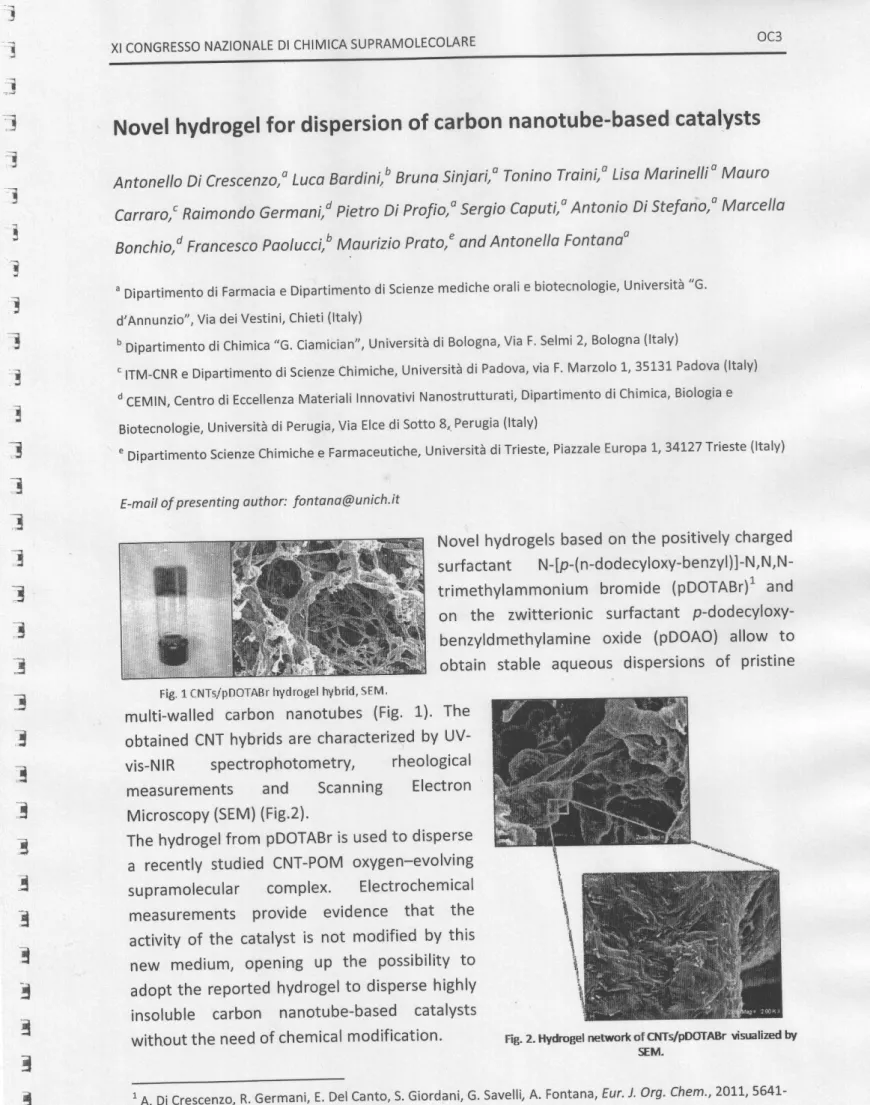UNrvnRsrrÀ
Dri$Lr
Srunr
ur P*nora
Sw
Z0L3
Xl Congresso
Nazionale
di Chimica
Supramolecolare
$ocietÒ Chimicq ltoliano
'3
I
::J
'1
.t
i
.'Ì .f
!
I
f
3
3
3
:E
3
3
3
I dT
T I3
E
t
T
I
t
3
t
I
X I C O N G R E S S O N A Z I O N A L E D I C H I M I C A S U P R A M O L E C O L A R E oc3Novel hydrogel
for dispersion
of carbon nanotube-based
catalysts
Antonello Dí Crescenzo,o Luco Bardini,b Bruna Siniari,o Tonino Troini,o Lisa Morinellio Mauro Carrero,, Roimondo Germonid pietro Di Profio,o Sergio caputi,o Antonio Di Stefano,o Marcella
Bonchiod Francesco paolucci,b Maurizio Prato," ond Antonella Fontanao
" D i p a r t i m e n t o d i F a r m a c i a e D i p a r t i m e n t o d i S c i e n z e m e d i c h e o r a l i e b i o t e c n o l o g i e , u n i v e r s i t à " G ' d ' A n n u n z i o " , V i a d e i V e s t i n i , C h i e t i ( l t a l y ) b D i p a r t i m e n t o d i C h i m i c a " G . C i a m i c i a n " , U n i v e r s i t à d i B o l o g n a , V i a F . S e l m i 2 , B o l o g n a ( l t a l y ) " l r M - c N R e D i p a r t i m e n t o d i S c i e n z e c h i m i c h e , u n i v e r s i t à d i P a d o v a , v i a F . M a r z o l o 1 , 3 5 1 3 1 P a d o v a ( l t a l y ) o
cEMlN, centro di Eccellenza Materiali lnnovativi Nanostrutturati, Dipartimento di chimica, Biologia e Biotecnologie, Università di Perugia, Via Elce di Sotto 8^Perugia (ltaly)
" Dipartimento scienze chimiche e Farmaceutiche, università di Trieste, Piazzale Europa t,34L27 Trieste (ltaly)
E-mail of presenting author: fontona@unich'it
Novel hydrogels based on the positively charged surfactant N-[p-(n-dodecyloxy-benzyl)]-N,N,N-t r i m e N-[p-(n-dodecyloxy-benzyl)]-N,N,N-t h y l a m m o n i u m b r o m i d e ( p D O T A B T ) 1 a n d on the zwitterionic surfactant p-dodecyloxy-benzyldmethylamine oxide (pDOAO) allow to obtain stable aqueous dispersions of pristine
Fig. 1- CNTs/pOOTABr hydrogel l"rybrid, SEM'
multi-walled carbon nanotubes (Fig. 1-)' The obtained CNT hybrids are characterized by UV-vis-NlR spectrophotometry, rheological
m e a s u r e m e n t s a n d S c a n n i n g E l e c t r o n M i c r o s c o P Y ( S E M ) ( F i g . 2 ) .
The hydrogel from pDOTABT is used to disperse a recently studied CNT-POM oxygen-evolving s u p r a m o l e c u l a r c o m p l e x . E l e c t r o c h e m i c a l measurements provide evidence that the activity of the catalyst is not modified by this n e w m e d i u m , o p e n i n g u p t h e p o s s i b i l i t y t o adopt the reported hydrogel to disperse highly insoluble carbon nanotube-based catalysts without the need of chemical modification'
t
A. Di crescenzo, R. Germani, E. Del canto, S. Giordani, G. Savelli, A. Fonta na, Eur. J. org' chem',2071',5641'-5648.
Fig. 2. Hydrcgel network of CNTs/pDOTABT vismlized
